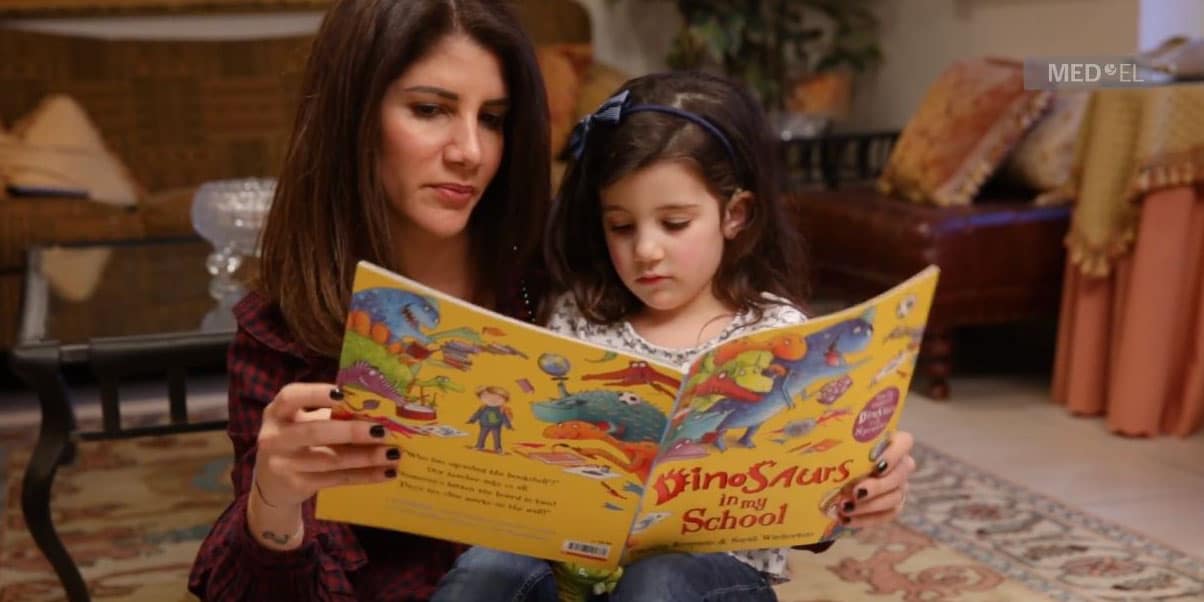MED-EL
Published Jan 09, 2019
Rehab At Home: What Is Theory Of Mind?

Today’s Rehab At Home post is about Theory of Mind (or ToM for short). For children with hearing loss, ToM can be challenging to master without support. In this blog post, we’ll show you how you can work on your child’s ToM while reading stories together.
What Is Theory Of Mind?
Theory of Mind is the ability to understand that we have our own thoughts, perspectives, beliefs and emotions, and to recognize that other people have thoughts, perspectives, beliefs and emotions that may be different from our own. Theory of Mind is the ability to “put yourself in another person’s shoes” and understand their perspective.
Why Is Theory of Mind Important?
ToM helps your child to become a successful communicator, and to build strong relationships with other people.
- ToM allows us to identify other people’s points of view, motives, wants, thoughts, and beliefs, and express our own.
- It’s important for your child’s social and emotional development. Having an understanding of their mind and others’ minds plays a significant role in building friendships and relationships.
- ToM helps children to communicate effectively using skills like empathy, persuasion, inference, reasoning, thinking critically, cooperation, and understanding narratives and texts.
- It helps to make conversations easier by allowing your child to predict what the listener already knows, what they might need to know, how they’re reacting, and what should be said next.
These ToM skills are woven throughout our everyday communication with others. Children often pick up these skills, and the language that goes with them, by overhearing others use this language over and over again, in different contexts and conversations. Children with hearing loss may have difficulty overhearing the conversations around them. This means they may have less exposure to situations where ToM concepts are used, and their development of these skills might be impacted.
How Can I Help My Child With Theory Of Mind?
Reading books with your child is a wonderful way to talk about other people’s perspectives, feelings and beliefs. This will help your child to learn that their own thoughts may be different from those of other people.
In this video, you’ll see Mia’s mum reading a story with Mia. She gives her daughter many opportunities to hear how the characters in the story think and feel. Mia’s mum reads the words on the page, but she also explains her thoughts, predicts the characters# thoughts and feelings and suggests what they might say. She uses words that describe thoughts and feelings such as “I think” and physical state terms such as “he’s hungry”.
What Activities Can We Do With Younger Children?
- Add emotion words such as excited, annoyed, embarrassed, shocked, and worried to describe your emotions and those of the characters in the story. This will help your child to identify their own and others’ emotions. Talk about why the characters might feel that way.
- Use different voices to reflect the character’s emotions to help your child to understand how the character feels.
- Talk about a time when you have felt that particular emotion or how you would feel if you were the character in the story. This will help your child to put themselves in the character’s shoes.
- Add mental state words such as know, think, like, want, hope, and guess to describe your thoughts and those of the characters. This will help your child to understand that different people have different thoughts and preferences.
- Talk about why the characters could be thinking certain things and predict what they will do next. This will help your child to understand that different people have different thoughts, and people’s actions are based on their thoughts.
What Activities Can We Do With Older Children?
When reading with your older child you will be able to add more complex language and be able to have more in-depth conversations with your child about the characters’ thoughts, perspectives, motives and emotions.
- Add more complex emotion words such as irritated, jealous, miserable, nervous, relieved, and terrified, to describe your emotions and those of the characters in the story. Talk about why the characters might feel that way.
- Add more complex mental state words such as remember, forget, imagine, prefer, wish, and believe, to describe your thoughts and those of the characters. This will help your child to understand that different people have different thoughts and preferences.
- Talk about the characters’ motives, why they could be thinking certain things, and predict what they will do next. This will help your child to understand that different people have different thoughts, and people’s actions are based on their thoughts.
- Talk with your child about why characters acted in certain ways in the story. For example: “Why did the wolf dress up as Grandma in Little Red Riding Hood?”
- Talk about what the characters could do to fix a problem in the story or what you would do differently if you were there. This will help your child to understand that different people act in different ways according to their thoughts and perspectives, and that there can be a number of different ways to react to a situation.
- Talk about a time that you have felt the way a character in the story did, or how you would feel if you were the character in the story.
Want more from Rehab At Home? Check out all the videos on our Rehab At Home intro page.
Have you heard about SONNET 2? Discover how our latest cochlear implant audio processor is made for your child.
Find out more about how cochlear implants work and how they could help you or your child.
MED-EL
Was this article helpful?
Thanks for your feedback.
Sign up for newsletter below for more.
Thanks for your feedback.
Please leave your message below.
Thanks for your message. We will reply as soon as possible.
Send us a message
Field is required
John Doe
Field is required
name@mail.com
Field is required
What do you think?
MED-EL


